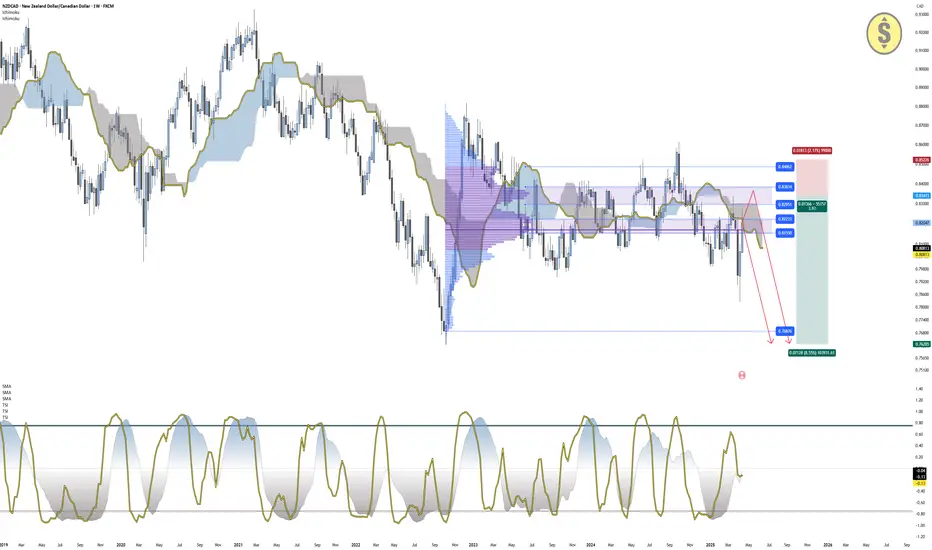The 
 NZDCAD pair is respecting a clear bearish market structure on the weekly timeframe. Price remains below the Ichimoku cloud (Span A at 0.8081 and Span B at 0.8218), confirming ongoing bearish momentum.
NZDCAD pair is respecting a clear bearish market structure on the weekly timeframe. Price remains below the Ichimoku cloud (Span A at 0.8081 and Span B at 0.8218), confirming ongoing bearish momentum.
Price is now hovering around the Point of Control (POC) from the volume profile of the last major move — between 0.822 and 0.815, an area of high transaction activity and potential resistance. This zone presents a valid area to initiate short positions, especially given the lack of bullish breakout.
However, the optimal supply zone lies slightly higher between 0.823 and 0.838, which also corresponds to the second-highest volume node in the current range. If price pushes into this area and shows rejection, it may offer a cleaner entry for higher reward setups.
The target for this bearish scenario is the previous swing low at 0.7687, which marks a significant support level. The invalidating level for the bearish bias is a break above 0.8480, which sits above the recent structural high.
Trade Setup Summary:
Short Entry Zone 1 (aggressive): 0.822 – 0.815 (POC area)
Short Entry Zone 2 (optimal): 0.823 – 0.838 (supply zone)
Stop Loss: Above 0.8480
Target: 0.7687
The TSI indicators are near neutral but slightly negative:
TSI(10): -0.13
TSI(20): -0.04
This confirms the bearish pressure remains, but the move is not oversold, leaving room for further downside continuation.
The New Zealand dollar remains under pressure due to softening economic data and expectations of dovish monetary policy from the RBNZ, while the Canadian dollar has recently found support from stronger oil prices and relatively stable BoC guidance. Although both currencies are commodity-linked, CAD's correlation with energy gives it an edge in current conditions. As long as this divergence holds, the bias on NZD/CAD remains to the downside, in line with the current technical structure.
Disclaimer: This content is for educational and informational purposes only. It does not represent financial advice or a recommendation to buy or sell any financial instrument. Trading involves risk, and you should only trade with money you can afford to lose.
Price is now hovering around the Point of Control (POC) from the volume profile of the last major move — between 0.822 and 0.815, an area of high transaction activity and potential resistance. This zone presents a valid area to initiate short positions, especially given the lack of bullish breakout.
However, the optimal supply zone lies slightly higher between 0.823 and 0.838, which also corresponds to the second-highest volume node in the current range. If price pushes into this area and shows rejection, it may offer a cleaner entry for higher reward setups.
The target for this bearish scenario is the previous swing low at 0.7687, which marks a significant support level. The invalidating level for the bearish bias is a break above 0.8480, which sits above the recent structural high.
Trade Setup Summary:
Short Entry Zone 1 (aggressive): 0.822 – 0.815 (POC area)
Short Entry Zone 2 (optimal): 0.823 – 0.838 (supply zone)
Stop Loss: Above 0.8480
Target: 0.7687
The TSI indicators are near neutral but slightly negative:
TSI(10): -0.13
TSI(20): -0.04
This confirms the bearish pressure remains, but the move is not oversold, leaving room for further downside continuation.
The New Zealand dollar remains under pressure due to softening economic data and expectations of dovish monetary policy from the RBNZ, while the Canadian dollar has recently found support from stronger oil prices and relatively stable BoC guidance. Although both currencies are commodity-linked, CAD's correlation with energy gives it an edge in current conditions. As long as this divergence holds, the bias on NZD/CAD remains to the downside, in line with the current technical structure.
Disclaimer: This content is for educational and informational purposes only. It does not represent financial advice or a recommendation to buy or sell any financial instrument. Trading involves risk, and you should only trade with money you can afford to lose.
Trade forex, indices, stocks and metals with up to US$100.000 in company's funding.
Complete a challenge to access funding or go for instant deposit.
Trading involves substantial risk. Not financial advice
Complete a challenge to access funding or go for instant deposit.
Trading involves substantial risk. Not financial advice
Disclaimer
The information and publications are not meant to be, and do not constitute, financial, investment, trading, or other types of advice or recommendations supplied or endorsed by TradingView. Read more in the Terms of Use.
Trade forex, indices, stocks and metals with up to US$100.000 in company's funding.
Complete a challenge to access funding or go for instant deposit.
Trading involves substantial risk. Not financial advice
Complete a challenge to access funding or go for instant deposit.
Trading involves substantial risk. Not financial advice
Disclaimer
The information and publications are not meant to be, and do not constitute, financial, investment, trading, or other types of advice or recommendations supplied or endorsed by TradingView. Read more in the Terms of Use.
